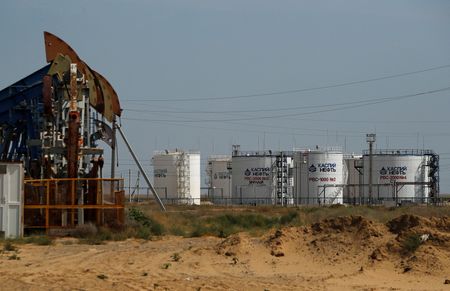By Shariq Khan
NEW YORK (Reuters) -Oil prices rose over 2% on Thursday as producers assessed the impact on output in the U.S. Gulf of Mexico after Hurricane Francine tore through offshore oil-producing areas before being downgraded to a tropical storm.
Over 730,000 barrels per day, or nearly 42%, of Gulf of Mexico oil output was shut-in due to storm Francine on Thursday, the U.S. Bureau of Safety and Environmental Enforcement said.
U.S. West Texas Intermediate crude futures rose by $1.66, or 2.5%, to settle at $68.97 per barrel. Brent crude futures rose by $1.36, or 1.9%, to $71.97 per barrel.
Both contracts had gained more than 2% on Wednesday as companies evacuated offshore platforms due to Francine. The disruptions are estimated to reduce output this month from the Gulf of Mexico by around 50,000 barrels per day, UBS analysts said.
Some analysts, however, cautioned that Francine’s impact could be short-lived, as it lost intensity quickly after making landfall in Louisiana on Wednesday evening. That could turn the oil market’s attention back to a lack of global demand, Alex Hodes, an analyst at StoneX, told clients in a note.
Oil and fuel export ports from south to central Texas had already reopened on Thursday and refineries were also ramping up.
Concerns about weak global oil demand, particularly from top importer China, have weighed heavily on prices in recent months. Brent crude futures settled near a three-year low on Tuesday after the OPEC+ producer group slashed its annual demand growth forecasts for the second month in a row.
The International Energy Agency on Thursday lowered its 2024 demand growth forecasts by more than 7% to 900,000 bpd, citing weak demand in China and feeble growth in other regions.
The U.S., the top consumer of oil, is also flashing signs of weak demand. Oil stockpiles rose in the country last week as crude imports grew, exports dipped and fuel demand slumped, data from the Energy Information Administration (EIA) showed on Wednesday.
U.S. gasoline prices are trending towards a three-year low because of weak demand and abundant supplies, analysts said. U.S. gasoline consumption represents nearly 9% of global oil demand.
Market participants are also closely following a weeks-long crisis over control of Libya’s central bank, which has led to oil output and export reductions from the country. A preliminary agreement was reached last week to resolve the crisis, but the situation remains fluid.
Analysts at FGE said crude output in Libya is recovering and export loadings are resuming, but warned that a full recovery remains uncertain.
(Reporting by Shariq Khan and Arunima Kumar; Additional reporting by Ahmad Ghaddar, Katya Golubkova, Emily Chow, Jeslyn Lerh; editing by David Goodman, Jason Neely, Paul Simao and Cynthia Osterman)





